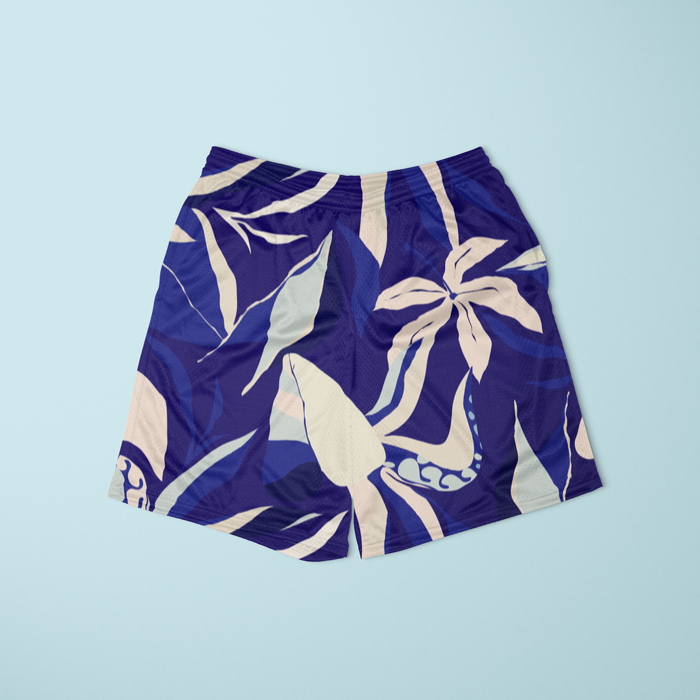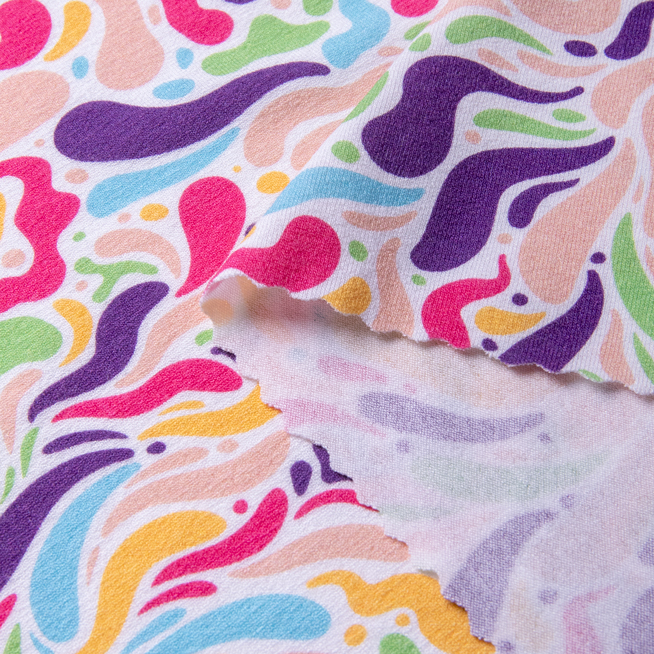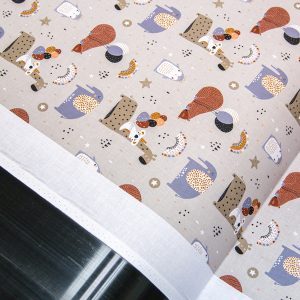Sewing lingerie is not only a fascinating hobby, but also a way to create unique, personalised pieces of clothing. If you are wondering which fabrics are the best to start your underwear sewing adventure, then this article is for you! Here you will learn about the most popular fabrics, their properties and their use.
Table of contents
- Is sewing underwear for sale a good idea?
- Types of underwear to sew
- What fabrics are used to sew underwear?
- Is polyester suitable for underwear?
- What do you need to sew underwear?
- Sewing underwear and selling it – a summary
Is sewing underwear for sale a good idea?
Wondering if sewing underwear for sale is a good idea? The answer is definitely yes! It’s a broad market that covers a variety of product categories, such as women’s underwear, men’s underwear, children’s underwear, as well as everyday, nightwear or sports underwear. Such diversity gives you the opportunity to find your niche, which is key to building your brand and gaining loyal customers. By choosing a specific target group, you can focus on designing products that best suit their needs, such as elegant night sets, comfortable sports bras or delicate underwear for children.
Underwear is an essential product in everyone’s everyday life, which ensures a constant demand for this type of product. This is important because it allows long-term production planning and business development based on stable demand. Customers regularly buy underwear, looking for both comfort and aesthetics, which gives a huge scope for creators.
To succeed in this industry, it is important to find your differentiators. These could be unique designs to catch the eye, breathable fabrics for comfortable wear, or product personalisation to meet individual customer needs. Personalised products, such as tailored underwear, can become your trademark and attract customers who value uniqueness and fit.
Another advantage of sewing lingerie is the relatively low entry threshold. You can start by fulfilling bespoke orders, which allows you to build a base of satisfied customers and allows you to adapt to their specific requirements. You don’t need to invest in a large production or expensive equipment straight away – a sewing machine, a few basic accessories and the right fabrics are all you need to get started. This allows you to grow your business gradually, testing different models and cuts before deciding on a larger production scale. An additional advantage is the possibility to work remotely – you can sew lingerie in your own home, which significantly reduces your start-up costs.

Types of underwear for sewing
The types of lingerie for sewing are extremely diverse, opening up many opportunities for makers to design and experiment with different cuts and fabrics. Sewing lingerie is not just about panties or bras – it encompasses a wide range of products that can be divided into several key categories.
Breakdown by gender and age
The basic criterion for dividing underwear is the gender and age of the users. Each of these categories has its own unique characteristics and requirements:
Children’s underwear : sewing underwear for children is a particular challenge, as the fabrics must be extremely soft, delicate and hypoallergenic. In this category, natural fabrics such as cotton, which is safe for a child’s sensitive skin, are most often chosen. When designing children’s underwear, it is advisable to keep in mind simple cuts and elastic trims that will not restrict the child’s movements.
Women’s underwear: Women have a wide choice when it comes to types of underwear. This category includes not only classic panties and bras, but also more specialised products such as corrective underwear, maternity underwear or nightwear. The choice of fabrics here varies greatly, from soft cotton to luxurious satin or lace. Each of these fabrics suits different needs – from everyday comfort to elegance for special occasions.
Men’s underwear: For men, the most common types of underwear are boxers, briefs and shorts. Depending on the wearer’s preference, underwear can be sewn in cotton for everyday comfort or in technical fabrics such as microfibre for sports underwear. It is important that men’s underwear is well-fitted and breathable, which translates into comfort.
Division by type of underwear
Dividing underwear by its type is another way of classifying what we can sew:
Bras: In this category, you can distinguish between everyday bras that provide comfort throughout the day, sports bras that offer support during physical activity, and push-up bras that add volume and shape the figure. Each of these types requires a different approach to sewing and choice of fabrics – for example, sports bras should be made from breathable and stretchy fabrics such as microfibre, while everyday bras are often sewn from cotton or viscose.
Panties: This category includes many cuts, such as hipsters, hipsters, thongs or panties. Each of these cuts has its own specific characteristics. Hips are a classic choice for comfort and versatility. Hipsters are slightly lower cut, making them ideal for wearing under low-rise trousers. Thongs, on the other hand, are a model that minimises the visibility of underwear lines under clothes, making them a popular choice for tight outfits.
Pyjamas: The sewing of pyjamas offers a huge scope for creativity and fabrics selection. You can range from simple cotton ensembles that are ideal for everyday wear to elegant satin pyjamas that are suitable for special occasions. Depending on the season and the wearer’s preferences, pyjamas can be sewn in light, airy fabrics for summer or warm fabrics, such as flannel, for winter.
Where to start?
For beginners, it will be easiest to start with simple cuts that do not require complicated sewing techniques. A good choice would be hip briefs, which have a simple construction and are easy to sew. Another model to start with is a basic underwire-free bra. Such a bra is less complicated to sew than padded models, while allowing you to experiment with different fabrics and patterns.
What fabrics are used to sew lingerie?
Choosing the right fabric is the key to successful underwear sewing. In the case of everyday underwear, it is worth noting a few important characteristics that the fabric should have. First and foremost, it should be flexible and stretchable, yet breathable and skin-friendly. It is also good if it is resistant to chemical and mechanical influences, such as washing.
Cotton is one of the most commonly chosen fabrics for sewing underwear. It is airy, soft and comfortable, which makes it ideal for everyday underwear. It has the added advantage of being able to use reactive printing to create unique patterns and colours that do not fade when washed.
Microfibre is a fabric that is gaining popularity in lingerie sewing. It is lightweight, stretchy and adapts perfectly to the body, providing a high level of wearing comfort. Microfibre is also resistant to wrinkling and dries quickly, making it an ideal choice for everyday and sports underwear.
Satin is a fabric that is associated with luxury and elegance. Its silky, smooth surface makes it a popular choice for pyjamas and nightwear. Satin is soft and pleasant to the touch, while giving lingerie an elegant look.
Viscose is another fabric that is perfect for sewing lingerie. Its fine cellulose fibre is soft, elastic and resistant to deformation, ensuring a high level of wearing comfort. Viscose is also breathable and absorbs moisture well, making it an ideal material for everyday underwear.

Is polyester suitable for underwear?
Polyester is a fabric that often evokes mixed feelings when it comes to sewing underwear. It is a synthetic fabric that has its advantages, but also some disadvantages, which means that the decision to use it should be well thought out.
On the one hand, polyester is characterised by its exceptional durability. It is resistant to stretching, does not lose its shape after many washes and is not easily damaged mechanically, making it an excellent choice for underwear that is expected to survive long and intensive use. This is why it is often used in sports underwear, where the durability of the material is crucial. Sports bras, leggings or boxer shorts made from polyester perform well during training, as the material has the ability to wick away moisture effectively. This keeps the skin dry, which is particularly important during intense physical activity.
However, polyester is not as breathable as natural fabrics such as cotton or viscose. Poor air circulation means that the skin can sweat excessively, leading to discomfort, especially during prolonged wear. For this reason, underwear made from polyester may not be the best choice for everyday wear when you want comfort all day long. It can lead to overheating of the skin, especially on warm days, and to a sticky and uncomfortably damp feeling.
It is also worth noting that polyester, being a synthetic material, can be less friendly to sensitive skin. For those prone to skin irritations or allergies, prolonged contact with this material can prove problematic. For this reason, it is worth considering combining polyester with other, softer materials that will improve wearing comfort and reduce the risk of irritation.
What do you need to sew lingerie?
Sewing lingerie is a creative process that doesn’t immediately require advanced equipment, but there are certainly a few basic tools and materials that will make the job significantly easier and improve the quality of the finished product. Whether you plan to sew lingerie as a hobby or are thinking of producing for sale, it’s a good idea to stock up on a few key items.
Sewing machine: Although lingerie sewing can be started without a machine, using one makes the whole process much quicker and easier. A sewing machine allows for precise and durable stitching, which is especially important for lingerie that needs to be comfortable and durable. When choosing a machine, look out for models that offer overlock or elastic stitch functions, which are ideal for sewing the elastic fabrics used in lingerie.
Erasers and lace: Elastics are an integral part of most lingerie designs. They can be elastics for sewing in at the waist, at the legs of panties or in the straps of bras. It is advisable to choose elastics that are elastic, but at the same time sturdy, which will provide adequate support and comfort. Lace, on the other hand, adds elegance and style, especially in the case of women’s underwear. When choosing lace, it is worth paying attention to its elasticity and softness so that it does not cause discomfort when worn.
Thread and needles: Choosing the right thread and needles is equally important. For sewing lingerie, elastic threads that will work with the fabric without causing the seams to break are best. You should also choose the right needles – stretch needles or ball needles, which are designed for sewing elastic and delicate fabrics such as microfibre, cotton or satin.
Blanks and templates: Well-fitting blanks and templates are essential when sewing lingerie. They allow you to cut the fabric precisely, which is crucial for a comfortable and aesthetically pleasing product. Die-cuts can be purchased ready-made or prepared yourself, adapting them to your individual measurements and preferences. It is worth investing in good quality paper or digital die-cuts for repeatability and accuracy when creating successive pieces.
Additional accessories: Depending on the type of lingerie you plan to sew, you may need various additional accessories. Buttons are essential when sewing sleep shirts or more advanced pyjama models. Other useful items include bra hooks, underwire, strap adjusters or fasteners. All these little details can make a significant difference to the functionality and aesthetics of the lingerie.
Materials: In addition to tools, it is crucial to choose the right materials. Underwear should be made of fabrics that are skin-friendly, breathable and flexible. Cotton, microfibre, satin or viscose are just some of the fabrics that work well in this role. When choosing fabrics, it is also worth paying attention to their durability and ease of care, which will affect the comfort of the finished product.
Tailoring tools : Basic sewing tools such as fabric scissors, pins, a tailor’s tape measure, cutting mat or tailor’s chalk are also essential when sewing lingerie. The right tools will allow you to prepare your sewing materials accurately and quickly, which is crucial for a professional end result.
Sewing lingerie and selling it – a summary
Sewing lingerie is not only a great way to develop your sewing skills, but also a great opportunity to enter the market with a unique product. By choosing the right materials and paying attention to detail, you can create lingerie that your customers will enjoy. Remember that the key to success is to find your niche and offer quality products that will meet the expectations of even the most demanding wearers.





